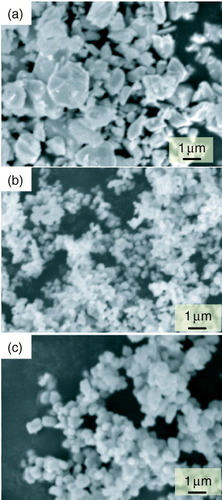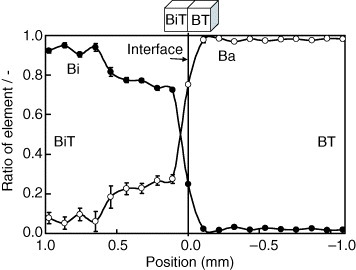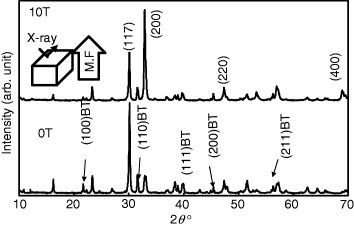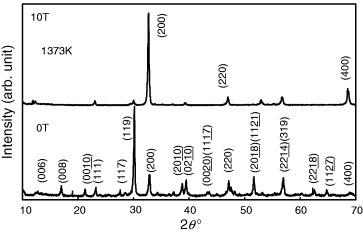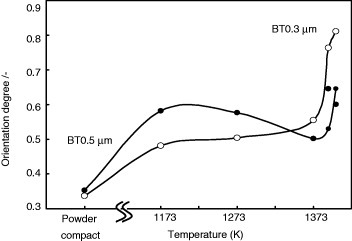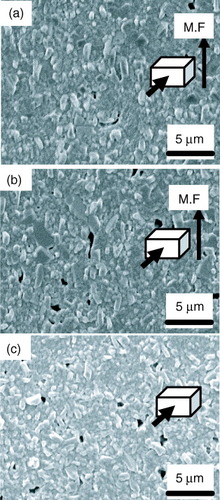Abstract
High magnetic field was applied to fabricate novel lead-free piezoelectric ceramics with a textured structure. A compact of crystallographically oriented grains was prepared by dry forming in a high magnetic field from a mixed slurry of bismuth titanate and barium titanate powders. Bismuth titanate particles with a size of about 1 μ m were used as the host material. In the forming process, the slurry was poured into a mold and set in a magnetic field of 10 T until completely dried. Bismuth titanate particles were highly oriented in the slurry under the magnetic field. The dried powder compact consisted of highly oriented bismuth titanate particles and randomly oriented barium titanate particles. Barium bismuth titanate ceramics with a- and b-axis orientations were successfully produced from the dried compact by sintering at temperatures above 1100 ° C.
Introduction
Bismuth-layered structure ferroelectrics (BLSFs) have a very high potential as new functional materials of the new generation [Citation1–6]. They are lead free and thus may replace the current PZT (PbxZr1 - xTiO3) system. However, their highly anisotropic properties hinder the applications. The piezoelectric constants are very high only along the a- and b-axis, but not along the c-axis [Citation4]. Therefore, to achieve high performance in applications, the crystals must be oriented to a specific direction. As-synthesized BLSF particles often exhibit platelike shapes with a well-developed c-face [Citation7]. The c-face laminated texture can be easily produced with conventional fabrication techniques such as hot pressing and tape casting [Citation4, Citation7–10]. However, a new method is needed to orient the c-axis normal to the lamination.
The fabrication method using a magnetic field can align crystal grains in ceramics to a designed direction [Citation11–14]. The method has outstanding merits. Firstly, the direction of orientation can be controlled easily and freely by adjusting the direction of magnetic field. Secondly, fine spherical particles can be used. This makes the subsequent densification very easy. Particle orientation within a dense structure has been reported for alumina, titania, and zinc oxide, which have a very low magnetic susceptibility (< |10-6|), using magnetic field of 10 T [Citation14–21]. Recently, we have reported the a- and b-axis-oriented bismuth titanate Bi4Ti3O12 (BiT) ceramics [Citation11, Citation22]. The optimum conditions for fabricating a well-oriented dense structure were experimentally studied. The dependences of particle size, magnetic flux density and sintering temperature on the orientation structure of ceramics have been established.
MBi4Ti4O15 (M = Ca, Sr, Ba) (MBTi) belongs to the BLSF class. It has a much higher dielectric strength than BiT, and is very promising as a piezoelectric material of the next generation, at least in certain applications. Preliminary experiments showed that ceramics with an oriented structure could be prepared by aligning synthetic MBTi powder in a strong magnetic field followed by sintering [Citation11, Citation22]. However, it was also noted that the synthesized MBTi powder had a platelike particle shape owing to the high crystalline anisotropy, and the densification during sintering was severely hindered.
Figure shows the novel two-step fabrication method used in the study. It consists of magnetic field alignment in the first step and a subsequent reaction sintering in the second step [Citation23, Citation24]. The advantage of the method is its ease of fabricating ceramics with both high density and highly oriented texture. BiT powder with a nearly equiaxed particle shape allows densification at low temperatures. We have successfully reported the fabrication of SrBi4Ti4O15 (SBTi) through the two-step method.
1 The key to fabricating crystal-oriented SBTi is that the guest cation Sr2 + should diffuse into BiT. Recalling that particles oriented in the magnetic field are only BiT, and not ST of cubic structure, the guest material Sr2 + should diffuse into BiT to maintain the oriented structure of BiT. However, diffusion of Sr2 + into BiT was slow and was strongly affected by the relative particle sizes of BiT and ST. The degree of orientation decreased with increasing SrTiO3/Bi4Ti3O12 ratio.
The objective of this study is to fabricate BaBi4Ti4O15 (BBTi) ferroelectric ceramics by the two-step method involving particle alignment in the magnetic field and a subsequent reaction sintering. In the first step, a mixed slurry containing BiT and BaTiO3 (BT) powders was set in the magnetic field. The powder compact has a- and b-axis-oriented BiT particles and randomly oriented BT particles. Barium bismuth titanate (BBTi) of a- and b-axis orientation can be obtained via the reaction sintering of BiT and BT;
2 The crystal direction of oriented BiT after sintering should be maintained as BaTiO3 particles reacted topotaxically (i.e. preserving initial orientation) on oriented BiT, as shown in figure . Although Ba2 + is larger than Sr2 +, the Ba2 + may diffuse into BiT particles.
Experimental procedure
Sample preparation
Bismuth titanate Bi4Ti3O12 powders, which were prepared via the solid reaction of Bi2O3 and TiO2 at 950 ° C, were used as raw material [Citation22]. The average particle size was nominally 1.0 μ m, and the specific surface area, measured by the BET method, was 2.5 m2 g-1. BaTiO3 particles (Sakai Chemical, Japan) were 0.3 and 0.5 μ m in diameter (figure ). A mixed slurry was prepared by ball milling with a dispersant for 24 h with a powder volume fraction of 30 vol%. The slurry (5 cm3) in a shallow plastic container was placed horizontally in a superconducting magnet (bore: 100 mm, TM-10VH10, TOSHIBA, Japan). The container was continually exposed to a magnetic field (10 T) for 1 day at room temperature until the slurry has completely dried. Reference samples were dried without magnetic field. The dried powder compacts were heated at 5 ° C min-1 to 1000–1150 ° C and held at that temperature for 1 h before cooling to room temperature. The orientations of particles in the powder compact and sintered bodies were determined by analyzing x-ray diffraction (XRD) patterns with the Lotgering method. Mass density was measured with the Archimedes method using distilled water as the immersion liquid. The specimen was polished and thermally etched for 1 h to examine the microstructure by scanning electron microscopy (SEM).
Testing of cation diffusion
The diffusion of cations such as Bi3 + and Ba2 + into another material was studied by a diffusion test. Each sintered body was made by dry pressing from BiT and BT powders. The pressure was about 50 MPa. Each BiT and BT powder compact was heated at 1200 and 1350 ° C, respectively. After machining and polishing to a 5 × 5 × 2 mm3 size, each sample was stacked and heated at 1100 ° C for 0–24 h. The cross section at the interface was observed and analyzed for Ba and Bi concentrations with SEM combined with energy dispersive x-ray analysis (SEM-EDX).
Results
Figure shows bismuth titanate (BiT) and barium titanate (BT) powders. The size of BiT particles ranged between 0.5 and 2 μ m; their shapes were irregular but not platelike. The two kinds of BT powders with particle size of 0.3 and 0.5 μ m shown in the figure were nearly spherical and had a mono-disperse size distribution. The crystal structure of BT at room temperature is a tetragonal, similar to a cubic system. The diameter ratios of BiT/BT were 3 and 5. Particle ratio may affect the reaction.
Figure shows the diffusion of Ba2 + and Bi3 + after 16 h at 1100 ° C. The cations had different distributions. Ba2 + diffused 0.6 mm, further than Bi3 + ions (0.1 mm). This indicated that more of the material BaBi4Ti4O15 (BBTi) was generated on the BiT side. Ba2 + content was constant at 0.0–0.5 mm inside BiT. The ratio of Ba2 + to Bi3 + was about 1–4, in agreement with the stoichiometry of BaBi4Ti4O15.
Figure shows XRD patterns of the powder compact dried with or without magnetic field. All the peaks derived from BiT and BT were detected in both XRD patterns. The intensity of some peaks of BiT changed in the sample prepared in magnetic field. The strongest reflection of BiT is 117; intensity of this reflection decreased for the sample prepared in magnetic field. Instead of the 117 peak, 200, 220 and 400 reflections, which were derived from the a and b faces, strengthened. The a- and b-axis of BiT particles in the compact prepared in magnetic field were oriented to the field. For BT, all reflections were similar and independent of the magnetic field.
Figure shows the XRD patterns of sintered samples heated at 1100 ° C. The diffraction angles for samples formed with and without magnetic field were the same as those of BBTi ceramics. The detected reflections of the sample formed with the magnetic field were 200, 220 and 400 of BBTi, i.e. BBTi crystals oriented to the a- and b-axis were produced. The crystal structure of BiT was maintained during the sintering and the peak intensity of the oriented face increased during sintering.
Figure shows variation of the Lotgering factor with sintering temperature. Lotgering factor quantifies the degree of orientation. Lotgering factors of the powder compact and sample heated at 1000 ° C were calculated using the BiT hk0 peak before reaction sintering. Lotgering factor increased with sintering temperature above 1050 ° C. The degree of orientation was constant throughout the sintering. At the last sintering stage above 1100 ° C, the degree of orientation increased rapidly. Particularly, the Lotgering factor of the sample heated at 1120 ° C (0.3 μ m BT powder) reached 0.8. The relative density of the sample also increased from 80 to 95% with annealing temperature from 1100–1120 ° C.
Figure shows the microstructure of BaBi4Ti4O15 ceramics fabricated with and without magnetic field. The anisotropic structures were observed in the sample produced with magnetic field and a subsequent reaction sintering. However, no additional anisotropic grain growth occurred for the sample via reaction sintering. The sizes of all the grains were less than 5 μm. The relative density of the sample was 95%.
Discussion
Let us consider the effect of sintering on the crystal structure. Figure shows that Ba2 + diffused preferentially into BiT. This natural tendency played an important role in maintaining the a- and b-axis oriented structure of BiT to BBTi after reaction sintering. The retention of the structure indicates that this reaction sintering on the BiT side proceeded topotaxically, as illustrated in figure . The resemblance of the crystal structures of BBTi and BiT affects the reaction diffusion on the BiT side for this topotaxical reaction. The number of perovskite layers m in a crystal structure is 3 for BiT and 4 for BBTi. Unoriented BBTi, of course, should also be produced at the BT side, which shows random orientation.
Ba2 + substitutes Bi3 + in BiT for being a BBTi structure, although the reason for the rapid diffusion of Ba2+ remains to be clarified. Charge neutrality might require that diffusion of 3 Ba2 + ions into the BiT side causes diffusion of 2 Bi3 + into the BT side. The sizes of Ba2 + and Bi3 + are also important for substitution from a comparison of Ba2 + and Sr2 + in a previous study.
The Lotgering factor of the sintered sample fabricated with 0.5 μ m BaTiO3 (BT), heated at 1120 ° C, was lower than that of the sample produced from 0.3 μ m BT, as shown in figure . The result indicates that the sample sintered from 0.5 μ m BT particles has a more random structure. The reaction sintering occurs at the interface of BiT and BT particles. The a- and b-axis oriented BiT structure is maintained by a preferential diffusion of Ba2 + from BT to BiT. The size of oriented BBTi reflects the size of BiT particles (1.0 μ m). Unoriented BBTi grains, however, are generated at the BT side; their size is smaller than BT grains (0.5 and 0.3 μ m). Smaller random BBTi grains can be easily absorbed on to large oriented BBTi grains during the sintering. Some large random BBTi grains may survive the sintering. The size ratio of the host material BT to the guest material BBTi is important for the development of an oriented structure by grain growth.
Conclusion
a- and b-axis-oriented BaBi4Ti4O15 ferroelectric ceramics were fabricated by alignment in magnetic field and subsequent reaction sintering. Bismuth titanate particles with a size of about 1 μ m were the host material. Barium titanate, as a reaction additive, was used as the guest material. A well-dispersed slurry was prepared by mixing Bi4Ti3O12 and BaTiO3 powders. The ratio of particle size (Bi4Ti3O12/BaTiO3) was controlled. The slurry was poured into a mold and set in a magnetic field of 10 T until completely dried. Bi4Ti3O12 particles in the slurry were highly oriented in a magnetic field, that is, the dried powder compact consisted of highly a- and b-axis-oriented Bi4Ti3O12 particles and randomly oriented BaTiO3 particles. Barium bismuth titanate BaBi4Ti4O15 ceramics with an a- and b-axis orientation were successfully produced after sintering above 1120 ° C.
References
- TakenakaT 2002 J. Ceram. Soc. Japan 110 215
- TakenakaTNagataH 2005 J. Eur. Ceram. Soc. 25 2693 http://dx.doi.org/10.1016/j.jeurceramsoc.2005.03.125
- IkegamiSUedaI 1974 Jpn. J. Appl. Phys. 13 1572 http://dx.doi.org/10.1143/JJAP.13.1572
- TakenakaTSakataK 1980 Japan J. Appl. Phys. 19 31 http://dx.doi.org/10.1143/JJAP.19.31
- IrieHMiyayamaM 2001 Appl. Phys. Lett. 19 251 http://dx.doi.org/10.1063/1.1384480
- YiI-SMiyayamaM 1998 J. Ceram. Soc. Japan 106 285
- HornJ AZhangS CSelvarajUMessingG LTrolier-McKinstryS 1999 J. Am. Ceram. Soc. 82 921
- WatanabeHKimuraTYamaguchiT 1989 J. Am. Ceram. Soc. 72 289 http://dx.doi.org/10.1111/j.1151-2916.1989.tb06116.x
- PribosicIMakovecDDrofenikM 2001 J. Eur. Ceram. Soc. 21 1327 http://dx.doi.org/10.1016/S0955-2219(01)00011-5
- VoisardCDamjanovicDSetterN 1999 J. Eur. Ceram. Soc. 19 1251 http://dx.doi.org/10.1016/S0955-2219(98)00414-2
- MakiyaAKusanoDTanakaSUchidaNUematsuKKimuraTKitazawaK 2003 J. Ceram. Soc. Japan 111 702 http://dx.doi.org/10.2109/jcersj.111.702
- SuzukiT SSakkaYKitazawaK 2001 Adv. Eng. Mater. 13 490 http://dx.doi.org/10.1002/1527-2648(200107)3:7<490::AID-ADEM490>3.0.CO;2-O
- SuzukiT SSakkaYKitazawaK 2001 J. Ceram. Soc. Japan 109 886
- MakiyaAShoujiDTanakaSUchidaNKimuraTUematsuK 2002 Key Eng. Mater. 206–213 445
- SakkaYSuzukiT STanabeNAsaiSKitazawaK 2002 Japan J. Appl. Phys. Part 2 L1416
- SuzukiT SSakkaY 2002 Japan J. Appl. Phys. Part2 L1272 http://dx.doi.org/10.1143/JJAP.41.L1272
- SuzukiT SSakkaY 2002 Chem. Lett. 12 1204 http://dx.doi.org/10.1246/cl.2002.1204
- TanakaSMakiyaAKatoZUchidaNKimuraTUematsuK 2006 J. Mater. Res. 21 703 http://dx.doi.org/10.1557/jmr.2006.0098
- KagaHKinemuchiYTanakaSMakiyaAKatoZUematsuK 2006 J. Ceram. Soc. Japan 114 1085 http://dx.doi.org/10.2109/jcersj.114.1085
- SakkaYSuzukiT 2005 J. Ceram. Soc. Japan 113 26 http://dx.doi.org/10.2109/jcersj.113.26
- SuzukiT SOtsukaHSakkaYHiragaKKitazawaK 2000 Japan J. Powder Powder Metall. 47 1010
- DoshidaYTsuzukiKKishiHMakiyaATanakaSUematsuKKimuraT 2004 Japan J. Appl. Phys. 43 6645 http://dx.doi.org/10.1143/JJAP.43.6645
- TabaraKMakiyaATanakaSUematsuKDoshidaY 2007 J. Ceram. Soc. Japan 115 237 http://dx.doi.org/10.2109/jcersj.115.237
- SakkaYSuzukiT SUchikoshiT 2008 J. Europ. Ceram. Soc. 28 935 http://dx.doi.org/10.1016/j.jeurceramsoc.2007.09.039

